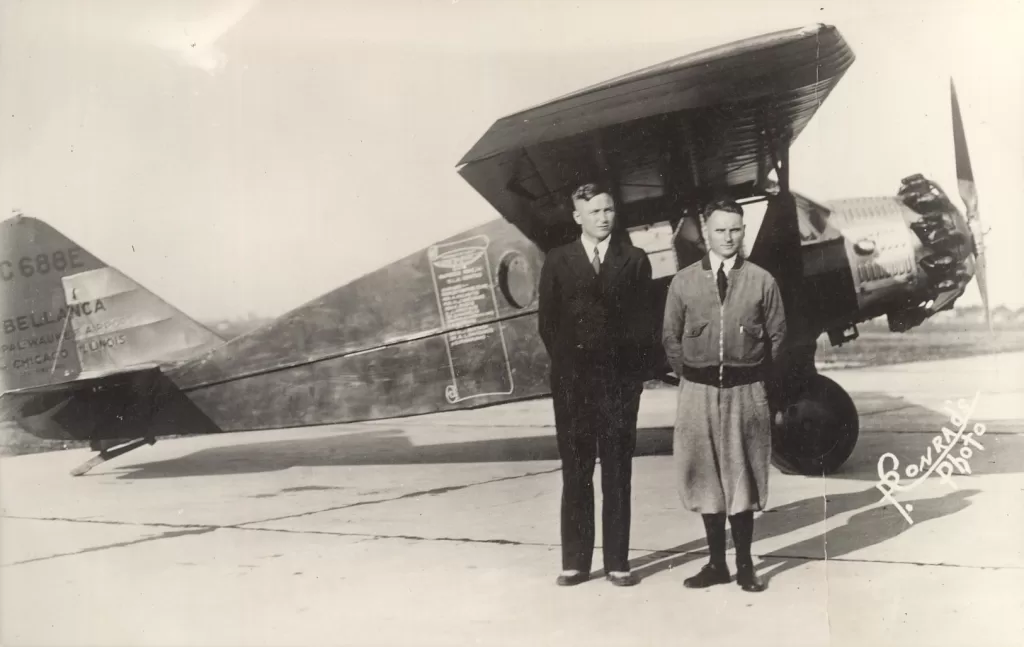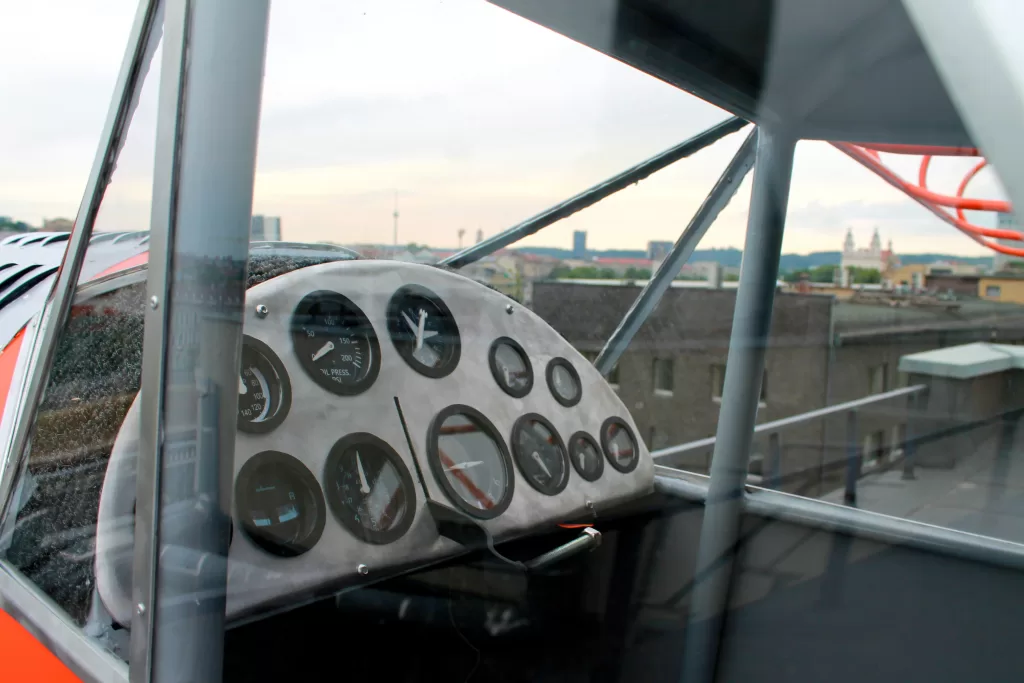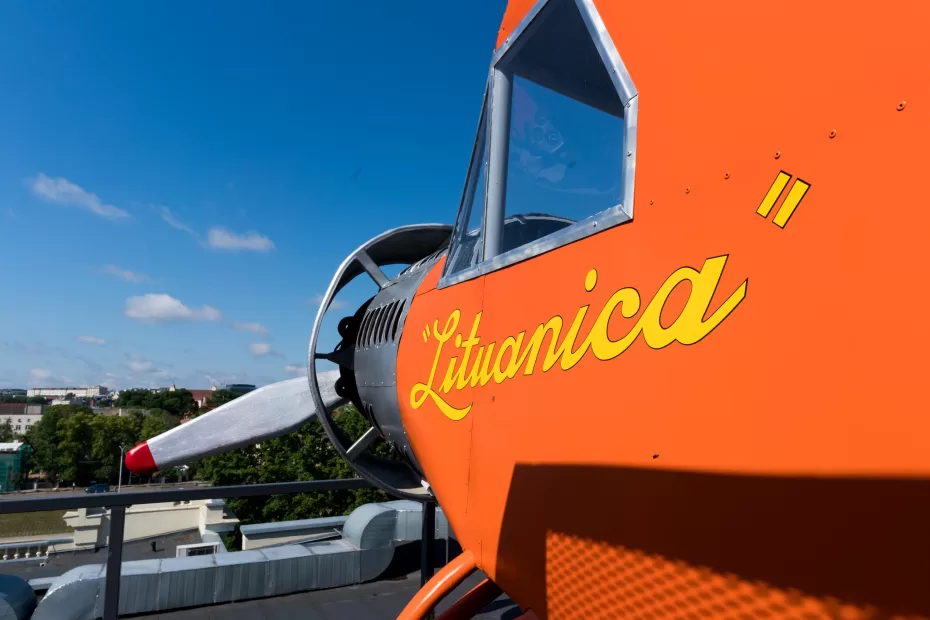The historic flight of “Lituanica” turns 90 this year. On that occasion, an interactive copy of the airplane of Steponas Darius and Stasys Girėnas landed on Energy and Technology Museum roof terrace. Museum visitors will be invited to start the plane themselves and briefly experience how the brave pilots felt when they embarked on a historic journey across the Atlantic in a small “Bellanca CH-300 Pacemaker” plane.
To cover almost 8,000 kilometres without stopping, in an early July 15 1933 morning, “Lituanica” took off with about 3,000 litres of gasoline and 100 litres of oil. The overloaded plane barely left the ground. For the following two days the pilots themselves took 4 litres of water, 6 sandwiches, fruits, coffee, vodka and cigarettes.
They spent the least amount of money on their own safety – the plane flew without lights, the pilots illuminated the instrument readings in the cockpit with a flashlight and had no radio equipment. Before the flight, when asked if they would have parachutes, Darius answered: “If “Lituanica” was only the property of Darius and Girėnas, then in trouble we would grab parachutes. But “Lituanica” is the identity and hope of all Lithuanians; we are determined to bring “Lituanica” safely to Kaunas or perish together”.
The presentation of the interactive plane will take place on July 14th, at 12 PM, on the roof terrace of the museum. The exposition will be open from July 14th visited during the museum working hours.


Darius and Girėnas near the “Lituanica” airplane, July 1933, New York, USA. Photo courtesy of Vytautas the Great War Museum
A matter of life and death
Energy and Technology Museum guides Karolina Koroliova-Barkova and Andrius Šatas came up with the idea of creating an interactive airplane on the roof terrace of the museum.
“In the days when aviation technology was not perfected, the first flights were both dangerous and impressive, the first pilots were brave, even a little crazy, risking their lives,” said Šatas.
Even before “Lituanica”, Darius and Girėnas had been involved in plane crashes. This not only did not deter them from further flights, but back then was also almost common in the pilots’ everyday life. “Their motivation is indescribable, this mentality is still fascinating. Today we take air travel for granted, but back then it was a matter of life and death. You understand this when you board a claustrophobic cabin, the plane flies at 300 km/h over the ocean. Only from the mistakes of these people have we learned and improved aviation technology so that today we can travel around the world safely,” the guide said.


Flight of “Lituanica” over New York, 1933. Photo courtesy of Kretinga Museum
Filled the gap in the capital
The project was supported by the Lithuanian Council for Culture and Vilnius City Municipality. Specialists of Vytautas the Great War Museum, Lithuanian Aviation Museum and Vilnius Gediminas Technical University shared historical photographs and knowledge.
Energy and Technology Museum staff inspected the replica of “Lituanica” in Lithuanian Aviation Museum and its remains in Vytautas the Great War Museum in Kaunas. “Darius and Girėnas are closely related to Kaunas. However, we do not present their flight, which is so important at the state level, in the capital. This is a gap in Vilnius museums that we wanted to draw attention to now, commemorating the 90th anniversary of the flight,” said the author of the project idea, art researcher Koroliova-Barkova.


“Lituanica” in Energy and Technology Museum
“The architectural possibilities of the Energy and Technology Museum made it a unique opportunity to place the exhibit on the roof and thus spread the message about statehood, our heritage and history,” she continued. “The exhibit is complemented by information stands. No less surprising than the flight itself are life or lesser-known facts, for example, that S. Darius first offered to fly over Atlantic to a boxer. We know well the journey itself, and today it’s still interesting to learn that Darius and Girėnas were simple, brave and persistent people.”


The “Lituanica” wing has returned
The interactive plane had to be built from scratch and was made by a vintage car restorer. He went to see the actual “Bellanca”, which has a serial number that differs by a couple of models from “Lituanica”, and captured the iconic details: the propeller, the engine cover, the window panes and the color. It is interesting that “Bellanca” planes were usually painted red, Darius and Girėnas repainted “Lituanica” in orange just for this flight.
In the interactive “Lituanica”, visitors will try to start the engine according to the pilot’s instructions. In addition, a unique exhibit, the wing of “Lituanica”, returned to the museum from the archive.


Even after many investigations, the causes of the crash remained unclear. To this day, different assumptions prevail in research conclusions: “ran out of gasoline”, “extremely bad weather conditions”, “fatigue”. There are also conspiracy theories. However, the influence of the Lithuanian feat was enormous.
“The creative team of the museum implemented a meaningful project – now we can present to visitors two brave pilots who have been making Lithuania famous for 90 years. In the plane, visitors will experience and understand what it feels like to fly across the Atlantic in such a small cabin. Today, no hangar would allow a plane without radio communication or rescue systems,” – assured Mykolas Bistrickas, director of Energy and Technology Museum. “The story of “Lituanica” inspires us to this day – just this year, Aurimas Valujavičius crossed the Atlantic in the rowing boat “Lituanica”, and such trips became possible even without human casualties.”

